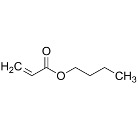What is Butyl Acrylate?
Butyl Acrylate is an acrylate monomer with a molecular formula of CH2=CHCOO(CH2)3CH3. It is a clear and reasonably volatile liquid which is slightly soluble in water and completely soluble in alcohols, ethers and almost all organic solvents. It is a reasonably flammable liquid with a flashpoint around 40° C and has a distinct fruity, pungent odour. It is easily miscible with other organic solvents and is readily polymerized with monomer molecules to create polymer chains.

How is Butyl Acrylate produced?
Butyl acrylate can be manufactured by reacting n-butanol with acrylic acid in the presence of an acid catalyst in an elevated temperature zone to produce butyl acrylate, water and other by-products. The product mixture is then purified in a distillation zone to create a higher purity of butyl acrylate. The typical yield of this process ranges between 94-97%.
How is Butyl Acrylate stored and distributed?
A chemical stockist would have a bulk petrochemical storage facility to maintain the product. Storage is normally in a cool, dry and well ventilated facility away from oxidising agents. Butyl acrylate should be kept out of direct sunlight, heat and open flames. Solvents such as butyl acrylate should be stored in drummed containers such as isotanks made of stainless steel, aluminium or carbon steel.
A bulk solvent exporter would normally distribute this solvent in bulk vessels or tank trucks. For transportation purposes, the product is classed as a flammable liquid with a fire hazard rating of 2. A full bulk chemical distributor would export the solvent throughout regions such as the UK, Europe, Africa and America. This product is a packing group 3.
What is Butyl Acrylate used for?
Butyl acrylate is primarily used in the production of homopolymers and co-polymers for use in water based industrial and architectural paints. It can also be used in cleaning products, antioxidant agents, enamels, adhesives, textiles, caulks and paper finishes. The double bond reactivity also allows for this product to be used as a chemical intermediary. The primary end user markets of this product would be the water, plastics, leathers, paints, adhesives and textiles industries.



